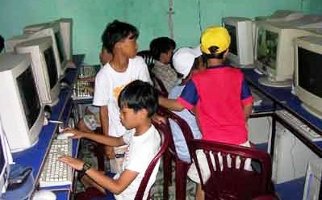Influenza A (H1N1) And The I-Café
 The scenario inside a i-café during peak hours is very much like that of a school classroom or even more congested sometime. Customers, mostly of school age, are seated side by side and converse with each other especially if they are playing the same game. Some people stand behind those seated and also talk with those using the computers.
The scenario inside a i-café during peak hours is very much like that of a school classroom or even more congested sometime. Customers, mostly of school age, are seated side by side and converse with each other especially if they are playing the same game. Some people stand behind those seated and also talk with those using the computers.
It is the physical contact and being together in a confined place especially air-conditioned areas where the same air circulates that our people are advised to avoid as much as possible. This is exactly a scene that our health authorities say could cause influenza A (H1N1) to spread fast. A distance of six (6) feet from one another is is believed to be the precaution that must be observed for people to be safe when someone they have been with was found positive of the virus.
The first case of a student found positive of A (H1N1) virus caused the school to close for a number days equivalent to the quarantine period for the disease. While this precaution could really help the campaign to prevent the spread of the disease, the negative effect to children’s education would still be there aside from the fear of catching the dreaded disease.
To prevent the spread of influenza A (H1N1), frequent washing of hands with soap and water is advised. I wonder how many among the cafés nowadays have the facilities to have their customers wash their hands before and after they use the computers. We must take note that the keyboards are the most likely medium where the virus could be transferred from one customer to another. How sanitized are your keyboards before a customer sit and use them? Do you clean them again after customers logged out and new customers log-in?
Another step that must be taken to prevent the spread of influenza A (H1N1) is to trace all the people that came in contact with a patient found positive of the virus. It should be easy for the schools to do so because they have a roster of names of their students. What do we have in a café? While you or your shop tender may know the regular customers of your café, how will you know when did they last play or use your computers? Who were they with in those days? These are important data needed when one of your customers got sick with influenza A (H1N1). Knowing who were with him in your café will help in tracing or identifying the persons who may also get the virus.
I remember the time when we were negotiating for the provisions of our local ordinance regarding truancy. Our local legislators wanted the café to maintain a logbook of the daily time-in time-out of customers in order to check if some students of minor age entered the establishment instead of going to school. The café owners objected and the provision was deleted from the ordinance. The customers’ logbook, whether manually or digitally done, would have serve the purpose of tracing the would-be influenza A (H1N1) patients. How would like to implement something similar before the situation becomes pandemic?




it may be too late, but i would have liked our airports to issue a bracelet for incoming passengers. that way, those who comes in contact with them would know that there is a possibility they may be carrying the virus. at least they would have the chance to do the necessary precautions.
in the case of icafes, a plastic 500ml bottle of alcohol only cost a few pesos. a clean rag cost less. i always try to keep them available in my shop, and my customers expects it of me. they are free to ask for them before they use the computer. they learned to do so a long time ago. i can’t be expected to clean it for them all the time since most are members and uses the computers even when i’m not looking. so they developed a habit of wiping off the keyboards and mouse with alcohol before using.
regarding a logbook, members can easily be traced since the timer software keeps track of our members’ logins. it’s the non members that would be a problem. fortunately, they are but a few.
so what’s my reaction? i doubt it could be implemented immediately, but it is worth a try. although i can’t be held liable if the customers themselves refuses to login. they’ld probably put in a false name anyway, knowing the kids’ mischievous nature.
i’d rather stick to educating them on cleanliness. if their parents fail to, at least they ‘ll learn in my shop. some already has. ^^
Thanks for the very nice and informative response. Let’s hope that cafés be spared on the spread of influenza A (H1N1). I hate to see the day when a bright boy in the government would propose ban on entry of customers to cafes just because “contact tracing” cannot be done among customers of a café.